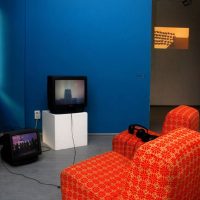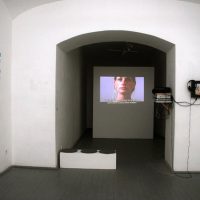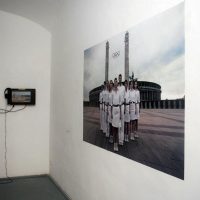The traveling project of Tamara Moyzes & Zuzana Štefková, MIDDLE EAST EUROPE draws attention to this phenomenon in the context of political art. It opens up the issue of the artist’s responsibility and observes how the interpretation of an artwork is transformed when it is placed into a different cultural context. The exhibition presents diverse work with regard to the subject the exhibiting artists chose. We find work dealing with “high politics” as well as personal human drama, with terrorism and peace activism, with generally comprehensible slogans and contextual testimonies alike while some of the works raise the question of the indisputable responsibility of the media itself.
The Labor exhibition, staying within the scope of the original concept of the project, chose techniques and strategies of re-enactment as its focus. Re-enactment became a frequently used tool in contemporary performing and media arts during the last decades (Life, Once More, Witte De With, Rotterdam, 2005; History Will Repeat Itself, Kunstwerke, Berlin, 2007; Sydney Biennále, 2008) and the artists exhibiting in Budapest set out to investigate and present the specific events, experiences using this technique. This is an opportunity for them to offer alternative interpretations as opposed to or complementing the often simplistic or biased mediated reality of TV channels and newspapers. They reproduce traumatic events form the Arab-Israeli conflict zone with varying intensity and different intentions and discover alternative narratives with more room for complex interpretation and more sensitivity than frozen moments on photographs and bare data provided by the news have to offer.
Re-enactment is an aid not only in dealing with personal trauma but also in evoking historic events that, in spite of the distance in time still generate strong emotions in people involved either directly or in an indirect way. Recalling the 1972 Munich events, when eleven members of the Israeli Olympic team were taken hostage (and raising the question of responsibility of the media), evoking the psychodrama workshop for young Arab men in Jenin and its documentation or presenting the audition for the motion-picture about the 1944 Hebron assassination assume different intentions and employ different techniques. What links however the works presented at Labor is the relevance of these past events in the here and now. “Artistic re-enactments are not simply affirming what has happened in the past, but rather they are questioning the present via repeating or re-enacting historical events that have left their traces in the collective memory.”
Further information:
www.middleeasteurope.info


